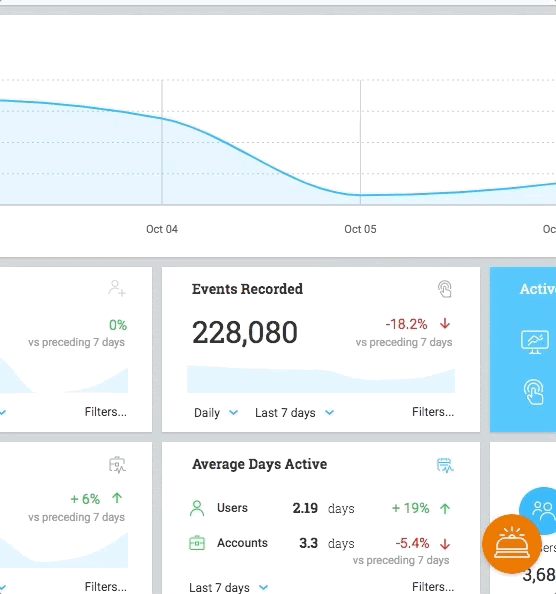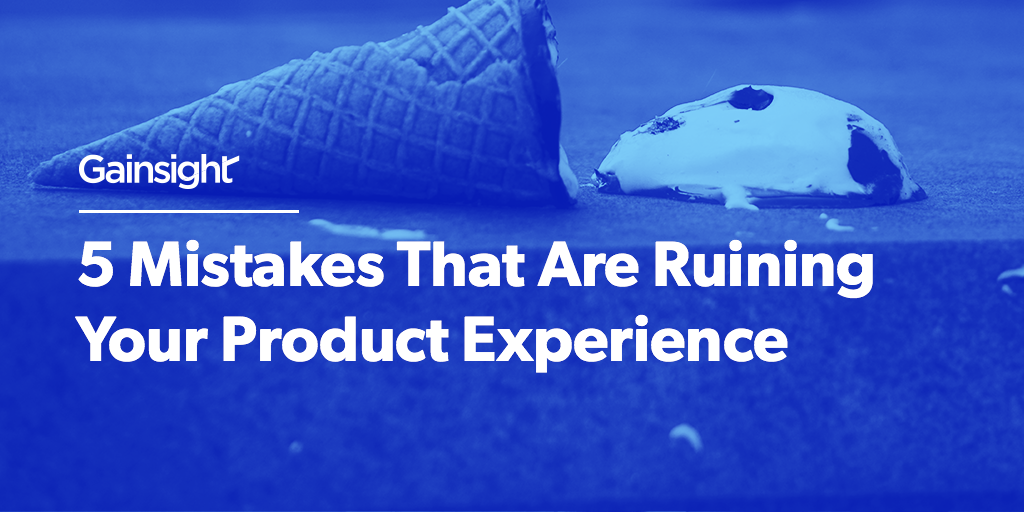Are you delivering a product experience your users want or are you just going through the motions?
In a world full of products offering the same results as yours, one of the best ways to stand out is through your product experience. What makes companies like Slack and Amazon so successful is their dedication to their user’s needs (you might know it as “customer obsession”). They build a product that people want to use.
So how do you get your product to that level? The first step is to make sure that your product experience is optimized for the user. Before your next roadmap planning meeting, make sure you’re not making any of the following product experience mistakes and make fixing them a priority.
Pro-Tip: If you want to skip right to the good stuff, register for a live demo of Gainsight PX. You’ll learn how to fix each of these mistakes as we guide you through the power of our Produce Experience Platform.
Mistake #1: You’re not using in-app engagements.
Throughout the day you get bombarded with communications from all over the place—email, Slack, on your phone, etc. In-app engagements cut through the noise and are incredibly useful for delivering the right information at the right time. If you’re not using in-app engagements, you’re missing out on a valuable lever for improving product usage, adoption, and user awareness. Here are some ways in-app engagements can improve your product experience:
- Are users dropping off at a certain feature? Launch an in-app engagement when a user visits that feature providing them with links to educational materials.
- Do you think an account could get more value from your product if they used a certain feature? Create an in-app engagement just for the users in that account driving them to the area of your product they need to see.
- Are you holding a user event? Set up an in-app engagement for users within a radius of the event urging them to register.
Case Study: Using In-App Engagements in Gainsight PX to Improve Adoption
Infobip, a global cloud communications company, leverages in-app engagements to help customers like Uber, Salesforce, and Burger King to better use and adopt their product. Check out this case study to see the real-life impact of using in-app engagements!
Mistake #2: You’re using too many in-app engagements.
The painful truth: not everything your company deems important is important to your users. If you’re mass-sending in-app engagements, users that find the message irrelevant will ignore it and they’ll start to ignore the ones that follow—it’s a real slippery slope. The solution?
- Create a framework or charter that everyone needs to stick to. This will provide checks and balances so sending in-app engagements isn’t a free for all. We’ve done step one for you. Download our TRUSt Framework for In-App Engagements to prevent a communication overload.
- Tailor your in-app engagements so they’re hyper-targeted to the best possible audience. You should, at the very least, be able to create cohorts around account and user type. Become familiar with the targeting abilities in your current application and shop around to see what’s out there because this is a need-to-have.
- Put limits in place to keep you from spamming your users. For example, Gainsight PX has engagement throttling capabilities that allow you to limit how many engagements users see based on time intervals and maximum thresholds.
Mistake #3: Your onboarding experience is one-size-fits-all.
Onboarding is a crucial moment in a customer’s journeys—so why would you throw them into an onboarding experience built for everyone? Chances are you have a few different user personas. Taking the time to create a customized onboarding experience for each use case will significantly increase product adoption and usage.
Here are some simple ways you can improve your onboarding experience:
- Use a combination of in-app engagements. Don’t stop at one walkthrough, use a combo of Guides, Hotspots, messages, and badges to guide users to “aha” moments!
- Reengage inactive users via email. Users dropping out of onboarding? Wake up “dead” users with an email that invites them back and provides them with a useful piece of content or a timeslot for a 1:1 conversation. With Gainsight PX, you can send emails based on usage data, so this process is a breeze.
- Rethink the way you measure onboarding. Go beyond vanity metrics and measure how your onboarding impacts revenue. This way you can prioritize key areas to improve.
Case Study: Improving the Onboarding Experience Using Powerful Usage Data Captured in Gainsight PX
Onclusive’s analytics software helps marketers and communications professionals drive business with their content. Using Gainsight PX, they can now remain hyper-aware of their onboarding experience and leverage usage data to dig deeper into problem areas. Learn how they’ve made a significant impact on user engagement in their case study!
Mistake #4: You’re not providing in-app support.
Most of your customers experience your company through your product. Your product experience carries a lot on its back—52% of users said that a bad product experience made them less likely to engage with a company. Providing a way for customers to report issues from directly inside your product will make for a much smoother experience. Compare this to having to leave the product (in a frustrated state) then having to navigate the best way to contact support.
An in-app resource—take Gainsight PX’s Knowledge Center Bot for example—provides instant assistance to confused or frustrated customers. Users are able to report bugs, request features, or just provide general feedback. It also provides quick access to Gainsight PX Documentation so users can find answers to their questions on their own.

Imagine the impact that this makes on your product experience! With in-app resources, you can turn a negative moment into a positive one instantly.
Mistake #5: Your product experience is product-focused, not user-focused.
How do you prioritize your product roadmap? Hopefully, you’re asking for customer feedback frequently, but is the important stuff making it to your product? The products that have cracked the code of success know that it’s a priority to put customer needs on the same pedestal as product/business needs. Here are some ways you can create a product experience that draws in users and keeps them coming back:
- Explore your different personas. Interview user types regularly to understand the workflows of admins, frequent users, and even once-a-week users in real-life settings. Have dashboards in place so you can track and analyze the usage of these different users. You might be surprised by what you discover!
- Work with prospect- and customer-facing teams to gather feedback. Incorporating feedback across the customer journey results in a product that drives perpetual value for users and growth opportunities for your business.
- Use data to make your case. It’s easy to slip into the habit of putting business needs first. After all, they’re usually the loudest. That’s where data comes into play. With stronger usage data, better analytics that allow you to derive insights, and well-collected customer feedback, you can back your claims for customer-centric product roadmap decisions.
Deliver the Best-in-Class Product Experience Your Users Deserve
Take the tips in this article to create a product that engages users. Delivering an amazing product experience requires a lot of work, but with Gainsight PX you can make a significant impact quickly. You can learn how to prevent each of these mistakes in our bi-weekly Gainsight PX demos. Simply register, sit back, and watch how you can better understand users, drive adoption, and collect feedback.

